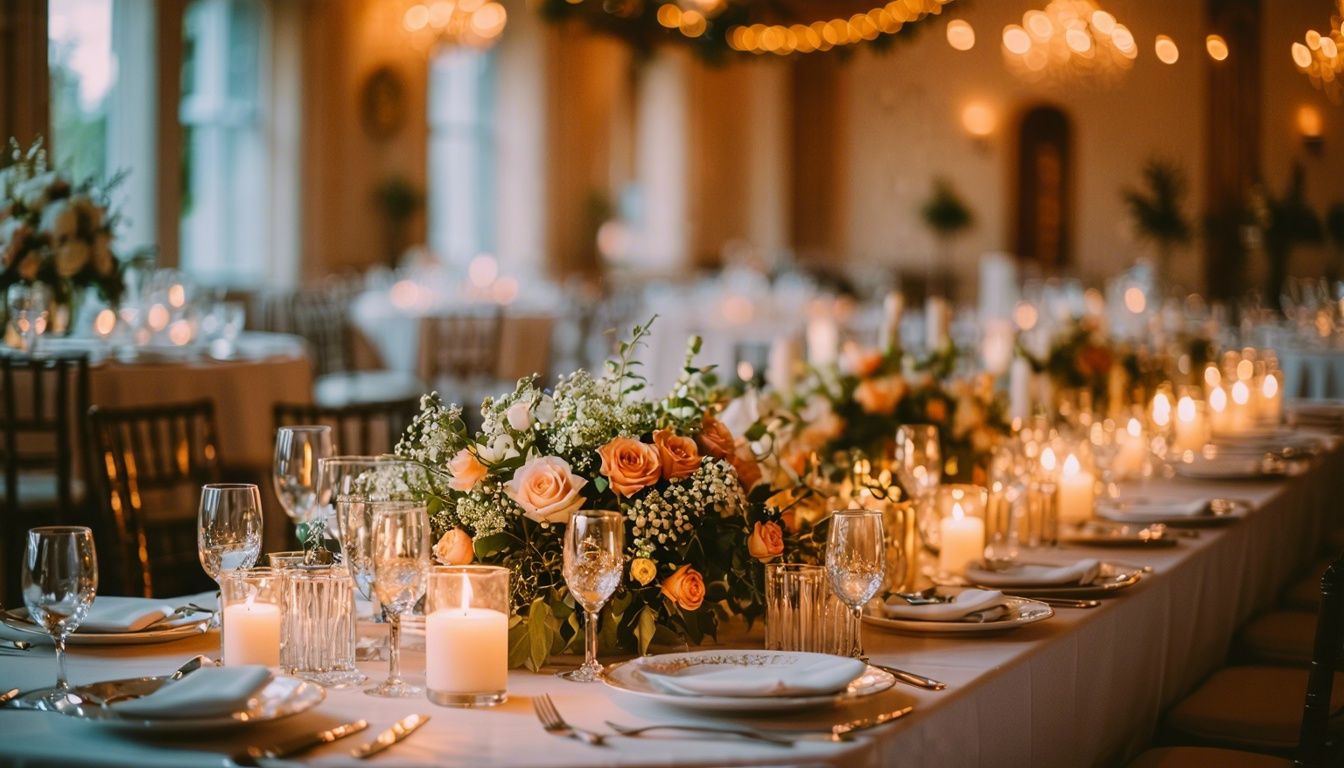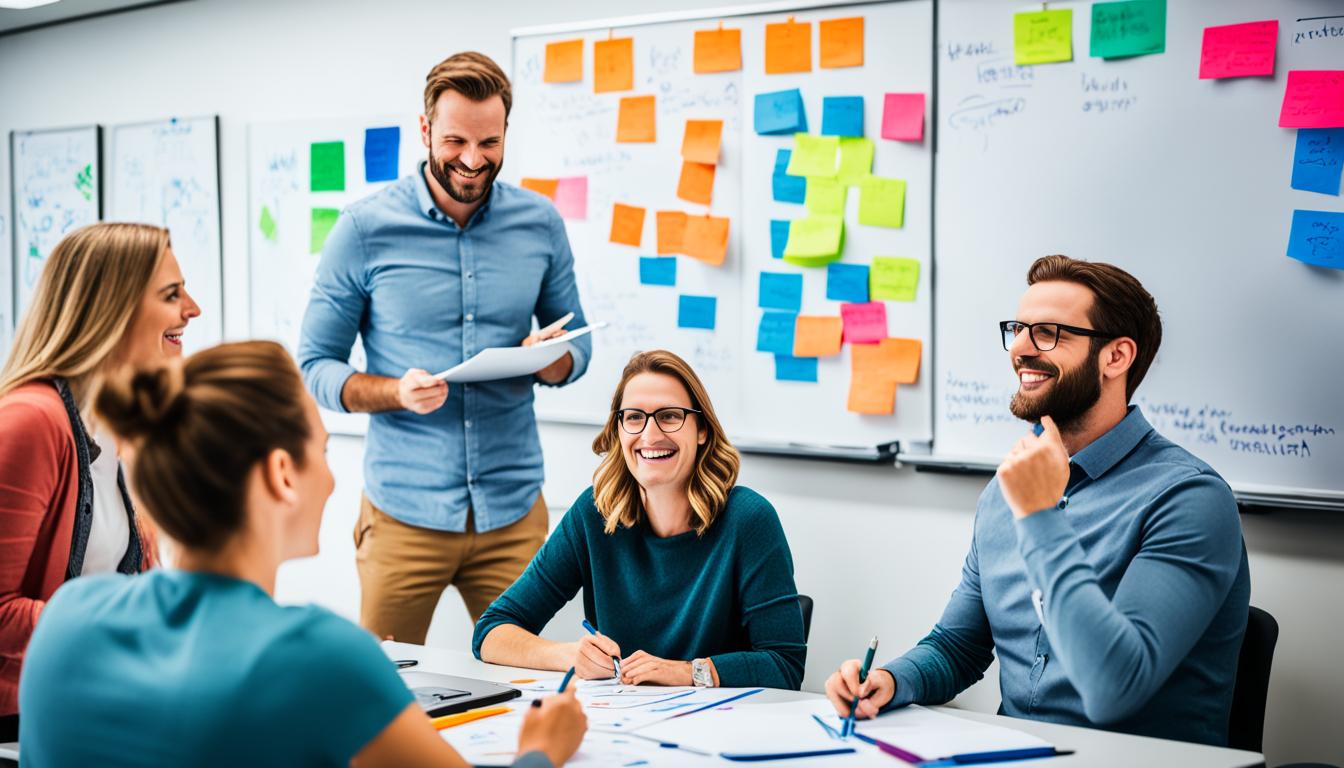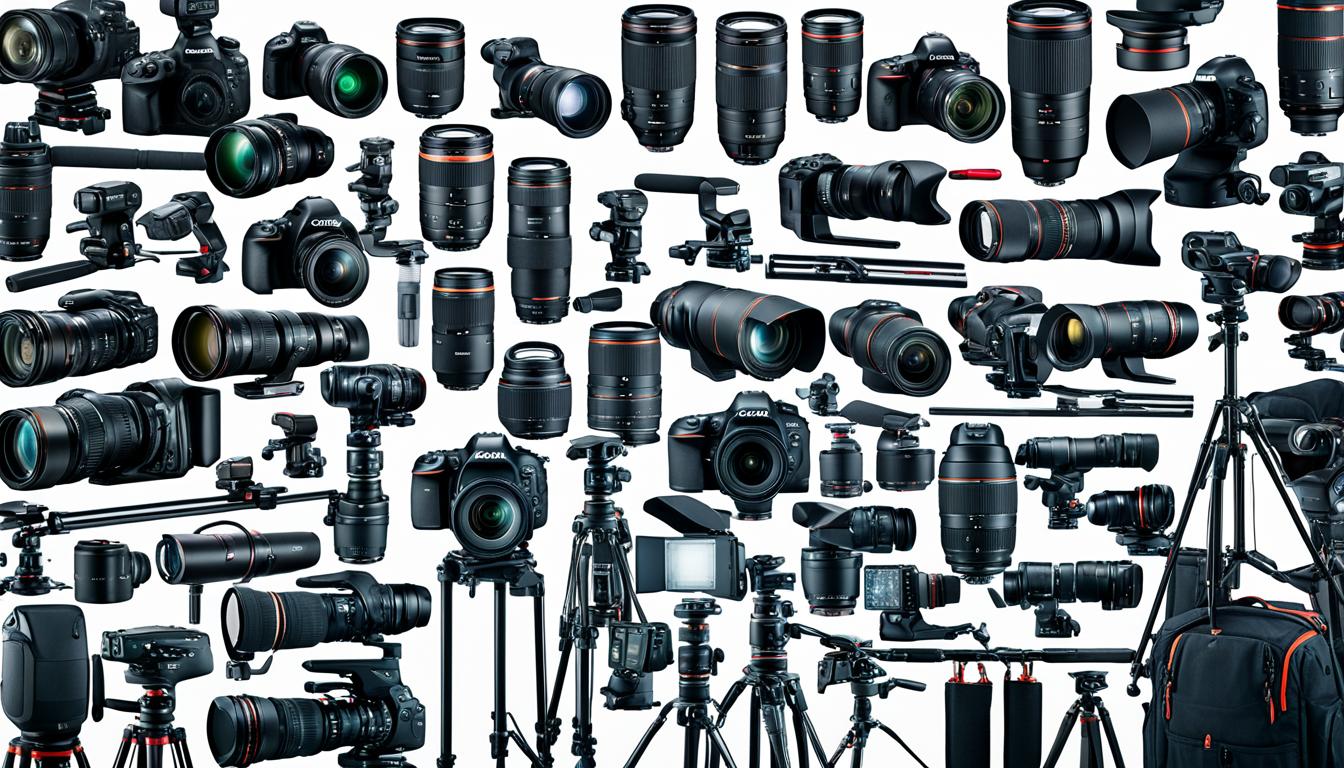Welcome to our guide on the top essential gear for event photographers! If you’re passionate about capturing stunning moments at events, having the right equipment is crucial. Whether you’re shooting weddings, concerts, or corporate events, having must-have photography equipment will ensure you’re equipped to capture those unforgettable shots. In this guide, we’ll walk you through the top gear for event photography, including professional camera accessories that will take your photography to the next level.
Key Takeaways:
- Invest in two camera bodies to have a backup in case of equipment failure.
- Having at least one lens with a minimum aperture of f/2.8 is ideal for indoor events.
- A flash is essential for illuminating subjects in low light situations.
- Don’t forget to carry extra batteries, flash battery packs, camera straps, and a reliable camera bag.
- Consider using a camera harness or strap system to distribute the weight and reduce strain on your body.
The Basic Photography Kit
A basic photography kit for event photographers should include two camera bodies, two lenses, and a flash. This setup covers the focal range and provides a backup in case of equipment failure. Having a flash is important for illuminating subjects in low light situations, which are common in event photography.
When preparing for an event, having the right gear is essential to capture those memorable moments. Let’s take a closer look at the basic photography kit that every event photographer should have in their arsenal.
Cameras
Having two camera bodies is a must-have for event photography. It ensures that you have a backup in case one camera malfunctions. Additionally, having two cameras allows for quick switching between different lenses without the need for constant lens changes. This saves valuable time and ensures you don’t miss any important shots.
Lenses
A variety of lenses is essential for capturing different perspectives and achieving various compositions. Two lenses that should be a part of your basic photography kit are:
- A wide-angle lens, such as a 24-70mm, is perfect for capturing group shots and wide event spaces. It allows you to fit more of the scene into the frame, giving a sense of context and atmosphere to your images.
- A telephoto lens, such as a 70-200mm, is essential for capturing distant subjects and close-up shots. It enables you to zoom in on details and isolate subjects, making it ideal for capturing candid moments and emotions.
Flash
A flash is crucial for event photography, as many events take place in low light conditions. It helps to illuminate your subjects and eliminate harsh shadows, resulting in more evenly-lit and professional-looking photos. Whether you’re photographing a dimly-lit indoor event or an outdoor evening celebration, a flash will greatly enhance your ability to capture stunning images.
| Camera | Lens | Flash |
|---|---|---|
| Camera Body 1 | Wide-angle lens (24-70mm) | Flash 1 |
| Camera Body 2 | Telephoto lens (70-200mm) | Flash 2 |
Having a basic photography kit consisting of two camera bodies, two lenses, and a flash will ensure that you are equipped to capture high-quality photos in any event setting. Now that we have covered the essentials, let’s dive deeper into lens choices and other important accessories for event photography.
Lens Choice is Key
The choice of lenses plays a crucial role in event photography, allowing us to capture the perfect shots and tell a compelling visual story. The right lens selection depends on the type of event and the desired outcome. Whether it’s a wedding, corporate event, or sports tournament, having the appropriate lenses in our arsenal can make all the difference in delivering exceptional results.
When it comes to indoor events, such as weddings or conferences, low-light conditions often prevail. It’s vital to equip ourselves with lenses that excel in these situations. Opting for lenses with a minimum aperture of f/2.8 allows us to capture sharp and vibrant images even in dimly lit environments. These lenses enable us to make the most of available light and achieve stunning results without relying heavily on artificial lighting.
Two main lenses that should find a place in our event photography kit are the versatile 24-70mm lens and the powerful 70-200mm lens. These lenses offer a range of focal lengths that cover a wide spectrum of shots commonly encountered during events.
- The 24-70mm lens allows us to capture wide group shots, document the ambience, and highlight the venue’s grandeur. Its flexibility makes it a versatile lens for various event scenarios.
- The 70-200mm lens, on the other hand, is ideal for photographing subjects from a distance. It enables us to overcome physical barriers, such as crowded spaces, and still capture impactful images without disrupting the event flow.
When it comes to sports photography, a different set of lenses becomes essential to freeze the action and capture those thrilling moments up close. For sports events, a 70-200mm lens is often the go-to choice. Its focal length allows us to isolate subjects from the surrounding chaos and create impactful images that convey the intensity and emotion of the event.
In more demanding sports scenarios, such as on-field action or capturing distant subjects, longer focal lengths become necessary. Lenses like the 200mm, 300mm, or 400mm provide the reach required to capture moments with precision and detail, ensuring our images stand out among the competition.
Remember, each event presents unique opportunities and challenges. As event photographers, having a diverse selection of lenses in our toolkit ensures that we are well-equipped to handle any situation and deliver professional results that exceed expectations.

Key Takeaways:
- Choose lenses with a minimum aperture of f/2.8 for indoor events with low-light conditions.
- Include a 24-70mm lens to capture wide group shots and document the event’s atmosphere.
- Incorporate a 70-200mm lens for capturing subjects from a distance without disturbing the event flow.
- For sports photography, a 70-200mm lens is a versatile choice, while longer focal lengths provide greater reach for on-field action.
- Having a diverse selection of lenses ensures we are prepared for any event and can deliver remarkable results.
Lighting Equipment
Lighting plays a crucial role in event photography, particularly in low-light situations. To ensure the best possible lighting conditions for capturing beautiful images, event photographers should invest in high-quality lighting equipment. Here are some essential lighting tools that every event photographer should consider:
Speedlight
The speedlight is a versatile and portable lighting accessory that attaches to the top of the camera. It helps to illuminate subjects in low-light situations and provides fill flash to soften harsh shadows. Having a speedlight as part of your equipment allows you to have direct control over the lighting conditions, resulting in more professional-looking images.
Flash Battery Packs
To enhance the performance of your speedlight and avoid delays in flash recycling time, it is recommended to use flash battery packs. These battery packs provide a steady power supply, allowing you to capture continuous shots without worrying about waiting for the flash to recharge. They are especially useful in fast-paced event environments where you don’t want to miss any important moments.
Off-Camera Flash Setup
An off-camera flash setup can take your event photography to the next level. By positioning the flash away from the camera, you can create more dynamic lighting effects and eliminate the harsh direct light that comes from using an on-camera flash. Using a light stand with an umbrella or softbox, you can diffuse the light and create a softer, more flattering illumination.
By incorporating lighting equipment such as speedlights, flash battery packs, and an off-camera flash setup, event photographers can elevate their images and capture stunning shots even in challenging lighting conditions.
Batteries and Camera Straps
As event photographers, we understand the importance of being prepared for any situation. That’s why having the right accessories, such as extra batteries and comfortable camera straps, is crucial to our success in capturing those unforgettable moments.
Batteries: Powering Your Creativity
Running out of power in the middle of an event is every photographer’s nightmare. That’s why it is essential to have extra batteries on hand. We recommend using Eneloop batteries, known for their reliability and long-lasting charge. With Eneloop batteries, you can focus on what you do best – capturing breathtaking images without worrying about losing power.
Camera Straps: Comfort and Support
Being on our feet for long hours while carrying multiple cameras can take a toll on our bodies. That’s where camera straps come in – they provide comfort and support, allowing us to focus on the task at hand. We highly recommend using a camera harness or strap system that helps distribute the weight evenly, reducing strain on the back and shoulders. This ensures that we can move freely and capture those memorable shots without any discomfort.
| Benefits of Batteries and Camera Straps | Batteries | Camera Straps |
|---|---|---|
| Ensures uninterrupted power supply | ||
| Reliable and long-lasting charge | ||
| Added comfort for long hours of shooting | ||
| Distributes weight evenly, reducing strain on the body |
Investing in high-quality batteries and ergonomic camera straps is a wise decision for event photographers. These essential event photography accessories not only provide convenience and peace of mind but also contribute to our ability to deliver exceptional results.
Camera Bags
When it comes to event photography, having a reliable camera bag is crucial for safely transporting and storing your gear. Whether you’re carrying heavy equipment or lighter loads, there are different types of camera bags that cater to your specific needs.
If you’re lugging around heavier gear, a wheelie bag is highly recommended. These bags come with wheels and a retractable handle, making it easier to transport your equipment without straining your back and shoulders. Plus, they often have extra compartments and padding to keep your gear secure and protected.
On the other hand, if you prefer a more lightweight and versatile option, a backpack is a great choice. Backpacks are designed with adjustable compartments and padded dividers, allowing you to customize the interior layout according to your gear. They also offer better mobility and flexibility, making it easier to move around during events.
When it comes to finding the perfect camera bag, there are several reputable brands to consider. Think Tank and Lowepro are renowned for their durable and secure camera bags, offering a range of options to suit different needs and preferences.
Additionally, it’s worth investing in a lens bag to provide extra protection for your individual lenses. Lens bags are usually compact and cushioned, ensuring that your lenses are safe from any potential damage during transportation.
With a reliable camera bag, you can have peace of mind knowing that your gear is properly protected, organized, and ready to capture those memorable moments during your event photography assignments.
| Camera Bag Type | Recommended Use | Brand |
|---|---|---|
| Wheelie Bag | Transporting heavier equipment | Think Tank |
| Backpack | Lighter loads and increased mobility | Lowepro |
| Lens Bag | Extra protection for individual lenses | Nikon |
Conclusion
Event photography is all about capturing memorable moments, and having the right gear is crucial for achieving professional-quality results. By following these event photography tips and investing in the recommended gear, photographers can ensure they are well-prepared for any situation.
One of the most important aspects of event photography is having two camera bodies. This provides a backup in case of equipment failure and allows photographers to easily switch between different lenses without having to constantly change them. Additionally, a selection of lenses is essential for capturing a variety of shots. A lens with a minimum aperture of f/2.8 is recommended for indoor events, while telephoto lenses are useful for capturing action from a distance.
Another key piece of gear for event photographers is a flash. Many events take place in low light situations, and a flash helps to illuminate subjects and create well-lit photos. It is also important to have accessories such as extra batteries, camera straps for comfort, and a reliable camera bag for safe transport and storage of gear.
By investing in professional gear for event photographers and following these event photography tips, photographers can capture stunning and memorable moments that will leave a lasting impression. Whether it’s a wedding, corporate event, or concert, having the right gear ensures that photographers are well-equipped to meet the unique challenges and opportunities that event photography presents.
FAQ
What gear is essential for event photographers?
The essential gear for event photographers includes two camera bodies, two lenses, and a flash. Other important accessories include batteries, flash battery packs, camera straps, and camera bags.
Why do event photographers need two camera bodies?
Having two camera bodies provides a backup in case one fails during an event.
Why is it important for event photographers to have a flash?
A flash is important for illuminating subjects in low light situations, which are common in event photography.
What lenses should event photographers have?
The choice of lenses depends on the type of event and desired shots. A 24-70mm lens and a 70-200mm lens are a good starting point for capturing a wide range of shots.
What lighting equipment do event photographers need?
Event photographers should have a speedlight that attaches to the top of the camera, along with a second flash as a backup. Battery packs and off-camera flash setups can also be beneficial.
Why do event photographers need extra batteries?
Extra batteries are important to ensure photographers don’t run out of power during an event.
Why are camera straps important for event photographers?
Camera straps help distribute the weight of multiple cameras and reduce strain on the body during long hours of shooting.
What type of camera bag should event photographers use?
Event photographers should use a reliable camera bag, such as a wheelie bag for heavier equipment or a backpack for lighter loads. Brands like Think Tank and Lowepro are known for their quality camera bags.
What is the importance of investing in professional gear for event photography?
Investing in quality gear ensures event photographers are prepared for any situation and can capture professional-quality images that leave a lasting impression.
What Essential Gear from Architectural Shots Guide Can Event Photographers Use?
Event photographers can benefit from incorporating some architectural photography equipment essentials into their gear. Items such as a wide-angle lens, a tripod, and a polarizing filter can help event photographers capture stunning architectural shots with clarity and precision. These tools can enhance the overall quality of event photography.




